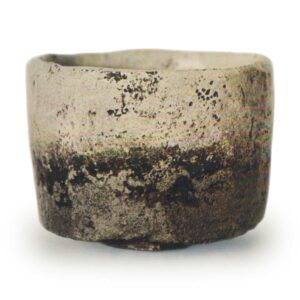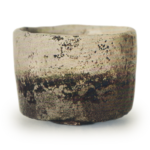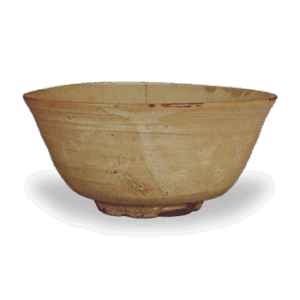

National Treasure
Height: 8.5cm
Diameter: 11.6cm
Outer diameter of foot: 5.4cm
Height of foot: 0.5cm
Fuji is a tea bowl of great elegance and distinction, and was selected by Koetsu for all of his five, seven and ten works. It is also known as Furisode-chawan (tea bowl in a long-sleeved kimono), and is the most famous of Koetsu’s works. There is a legend that when Koetsu’s daughter married into a wealthy family in Osaka, the family requested that she take this tea bowl wrapped in a kimono with a long, flowing sleeve, and for this reason it is also called the Furisode Tea Bowl. This is the only white tea bowl in Koetsu’s Raku style, and apart from Fujiyama, there is only one other Koetsu tea bowl with a box inscription written by Koetsu himself, so this is also considered to be a rare item.
The body is made of rough white clay, and a thick layer of transparent Raku white glaze has been applied to it, and there are cracks all over the surface. The lower half of the body and the inside of the cup are charred to a blackish-gray color, creating an interesting contrast between the white and black, making this a one-of-a-kind tea bowl. It is said that the name “Fuji” was given to this tea bowl because it resembles Mount Fuji, which is covered in snow, and that it was given the name “Fuji” because it is of unparalleled quality and is the best in the world.
The shape is thick with a full rim, with slight soft undulations, and the body is almost vertical, with a sharp waist and a flat, thick foot. It is hand-made, but the body, base and foot are shaped with a tool. It is a bold, yet finely detailed and richly textured tea bowl of outstanding quality.
Koetsu’s tea bowls include those with a full, rounded shape, such as Bishamon-do, Seppou and Otome, those with a sharp, almost angular shape, such as Fujiyama, Kaga and Tekkai, and those with a shape that is a compromise between the two, such as Amagumo, Shigure and Shoji. All of these are unique forms devised by Koetsu, and they are the models for Raku tea bowls.
Accessories:
Bag: Asagi paulownia pattern, ventilated
Inner box: Paulownia plain wood, with inscription on lid by Koetsu: “Fuji-yama, Taikoan”
Outer box: Cedar plain wood, paper pasted on reverse of lid by Hikita Gonbei
Kimono sleeve of Koetsu’s daughter, one sleeve (purple ground habutae with pine, bamboo and waterfall design embroidered with gold thread)
It is said that Koetsu’s daughter took it to a wealthy man in Osaka, and later, around the time of the Tempou era, Hikita Gonbei owned it, but in November of the 9th year of the Tempou era, Sakai Tadafumi, the head of the Sakai family, inherited it, and since then, it has been passed down to the Sakai family in Himeji.








